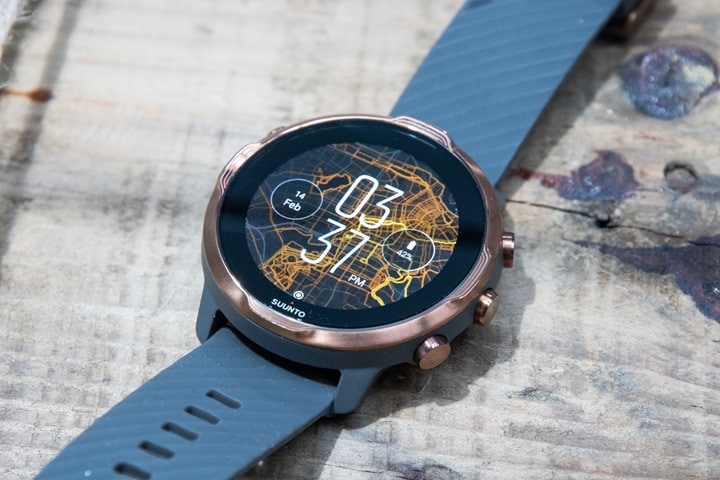
Let’s get this out of the way right from the first line: The Suunto 7 is both the best smartwatch they’ve ever made, while concurrently being the worst sport watch they’ve ever made. Fear not though, you don’t have to take my word for it – by the end of this review you’ll understand exactly why this is a pretty factual statement, not an opinion.
Back in early January at CES, Suunto announced the watch, its first on Wear OS. The move would be a considerable shift for a company whose products are typically built to last potentially days with GPS on, and numerous weeks in standby mode. Whereas Wear OS is perhaps best known for its limited battery life, certainly the opposite of Suunto’s roots. However, Wear OS does bring to the table a complete smartwatch that Suunto lacked: Music, contactless payments, and an app platform. Three things that realistically Suunto wasn’t going to be able to meaningfully develop on their own in 2020 (especially payments and music). They simply lack the pull in the industry at this stage.
Now, this type of watch wasn’t necessarily designed to fit Suunto’s core ‘run to the top of Mt. Blanc in sneakers before lunch’ crowd, but rather a less intense fitness crowd. In theory at least. In this review I’ll dive into whether or not they achieved that.
Oh – and if videos are more your thing, then hit play on the video below, where I dive into the menu system in a full walk-through, plus all the other analysis you’ll find in this post.
As always, if you found this review useful – hit up the links at the bottom. This review isn’t sponsored by Suunto or anyone else (nor do I take money or such from any companies I review). I got the products myself through normal retail channels. With that, let’s roll.
The Unboxing:
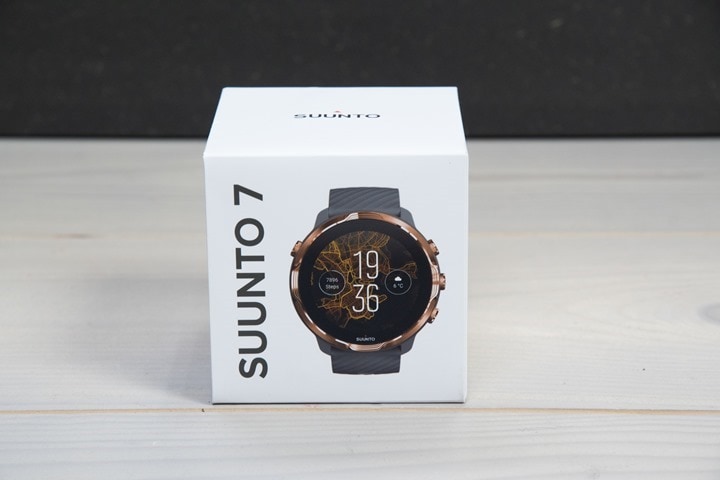
The Suunto 7 box isn’t terribly different than past Suunto product boxes. It’s got an outer sleeve that you slide off, showing you which exact bezel/color variant you bought. In my case, the copper colored bezel with a grey base. I like it!
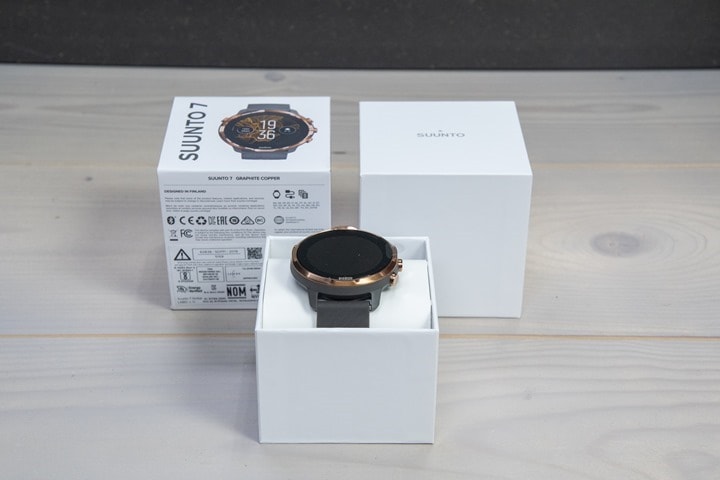
Inside is the watch wrapped around a cylinder of cardboard. Below it sat a paper reminding you of Suunto’s heritage around adventure. Inside said cardboard toilet paper roll is the charger, playing hide and seek.
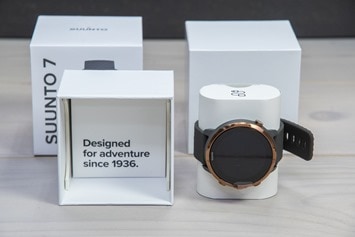
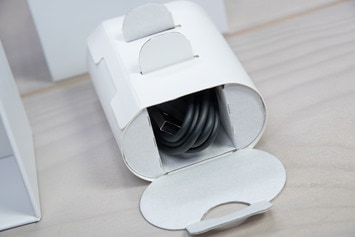
The charger is different than any other past Suunto product. It includes a magnet in it to keep the charger securely attached to the watch when charging.
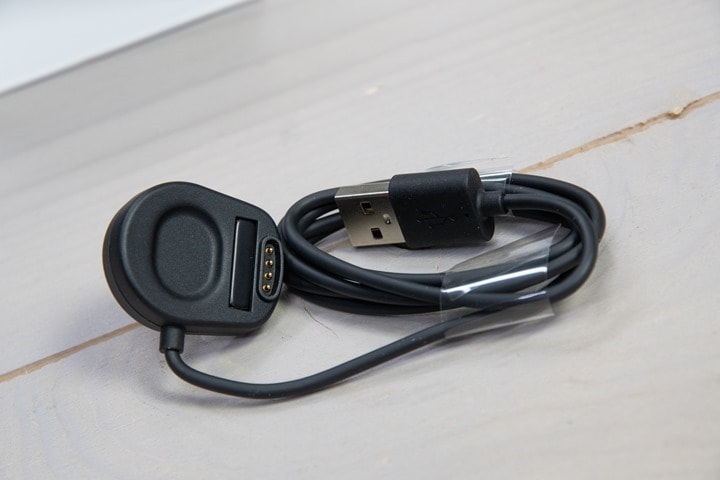
Here’s a complete family photo of what’s in the box, including all the paper bits you probably won’t read.
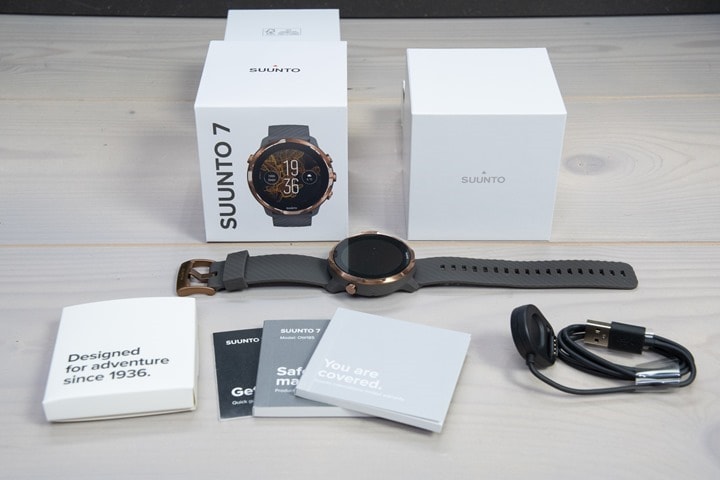
Then we’ve got a closer look at the bezel and buttons. They really look sharp here. And nearly a month later, they still look just as sharp. No scratches or such that I can see, despite my usual clumsiness with it.
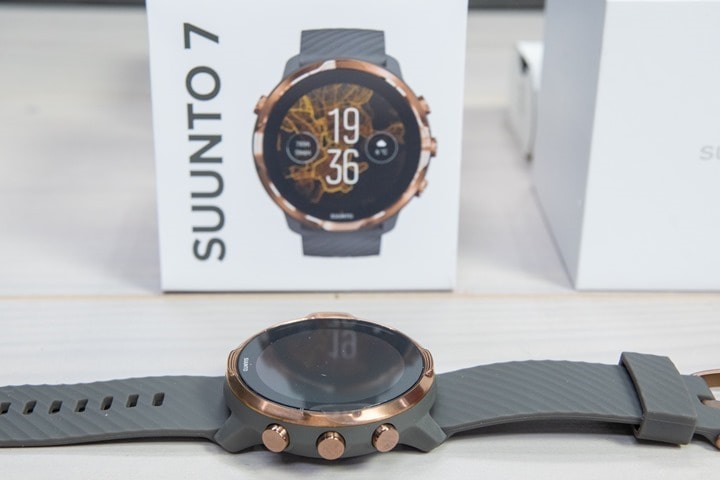
On the flip side is the optical HR sensor, covered by a small piece of protective film. I’m a bit surprised that Suunto decided to go with a piece of protective film this small, since we’ve seen repeatedly by other companies that users don’t realize they need to remove that small bit of plastic and then get upset about poor optical HR sensor accuracy. That’s why most companies use a much larger piece of plastic (if at all). In any case – yes, please remove it. This sensor needs all the help it can get.
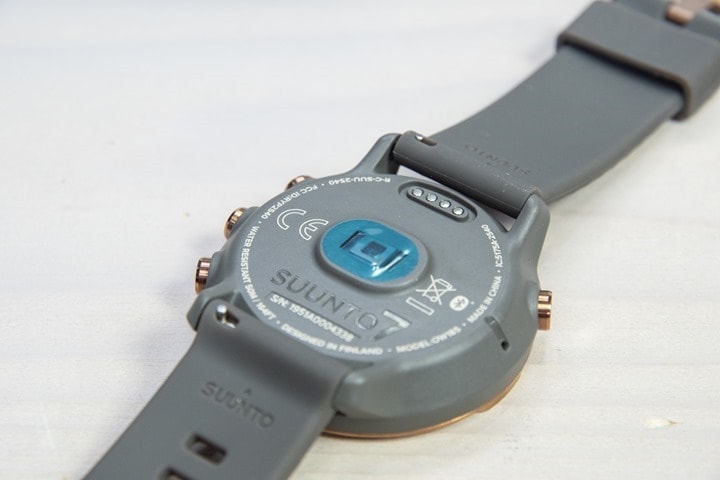
Finally, from a weight standpoint, the Suunto 7 weighs in at 67g, the Apple Watch Series 5 at 67g, and the Suunto 9 at 81g.
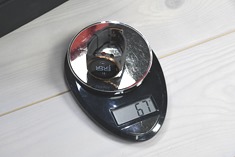
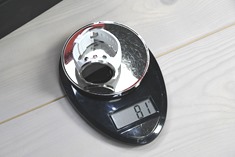
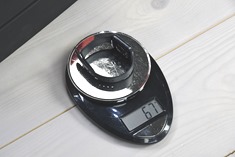
I really like the weight and feel of the Suunto 7. I think in part because the band strap is very un-Suunto like.
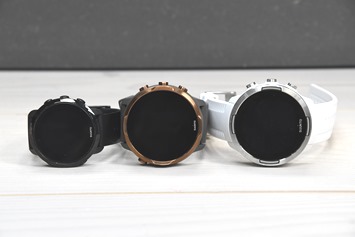
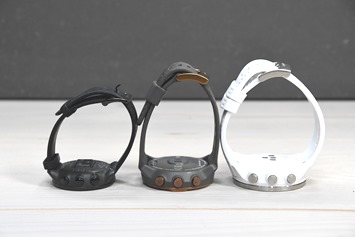
(Left to right: Suunto 3, 7, 9)
Historically their Suunto Spartan and Suunto 9 series watches have such clunky and hard-plastic band interconnect point where it attaches to the watch (at the poles/casing), whereas the material/transition here is super comfortable, and also really flexible. It’s good stuff.
The Basics:
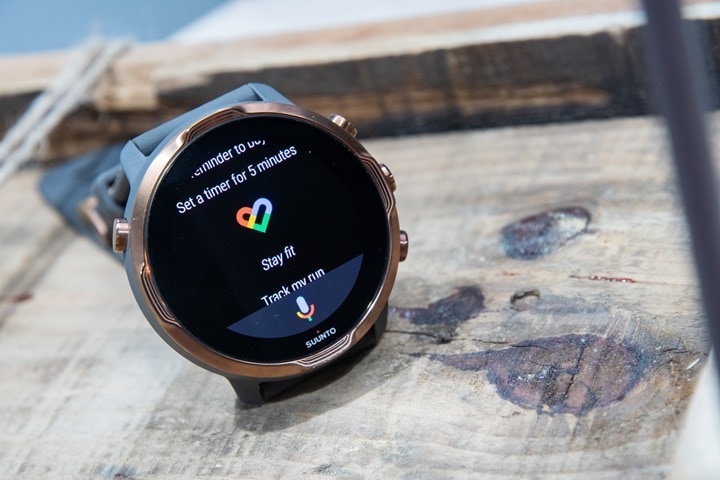
Before we talk workouts, we need to talk basics. At least watch basics. I won’t try and cover every aspect of Wear OS – instead, I’ll focus on the most common bits relevant to the sports/fitness crowd. Still, understanding that the core reason Suunto chose Wear OS is to compete with other smart watches means that these additional features (music, payments, apps) are critical to why someone would choose this watch over a traditional Suunto watch.
However, perhaps the best reason to choose the Suunto 7 is frankly the awesome watch face they’ve included. It’s a (mostly) live look at the heatmaps of workout data around you:
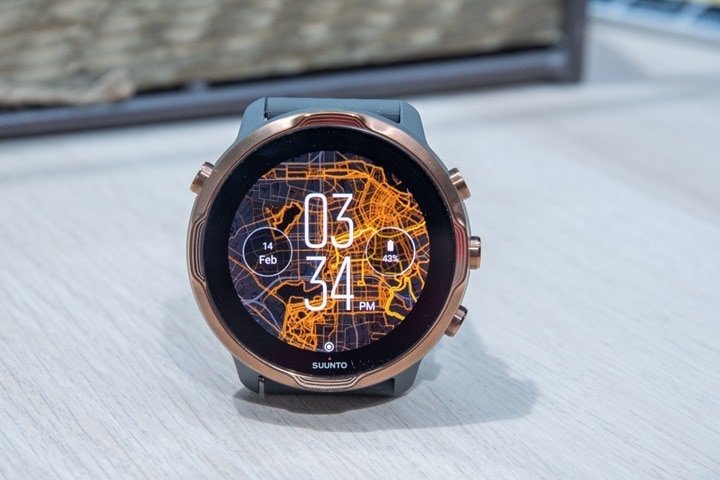
But it’s even cooler than that, it’s customizable. For example you can change the zoom level higher or lower, as well as even change the heatmap type. The default is running, but last week while down in the French Alps skiing I changed it to downhill skiing.
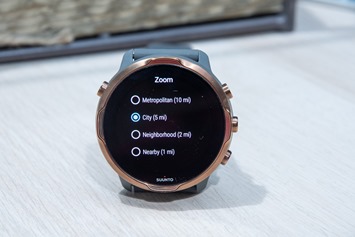
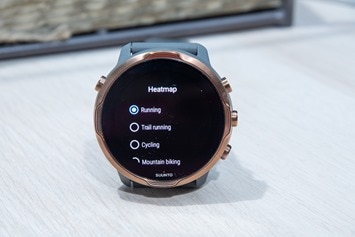
For the most part it works, but I do find the update rate finicky and unpredictable at best, especially when travelling. For example, last week it did show me the downhill ski trails around me near Chamonix. However, half the heatmap page was missing data (as if someone cut across it with a pair of scissors). It never updated.
Then, on the way back home, it updated immediately in both Geneva and Zurich with the heat maps during the short 90 minutes I was there. However, three days later now and it still hasn’t shown me back home in Amsterdam. I still see the Zurich airport maps.
If for some (really weird) reason heatmaps aren’t your thing you can also download a handful of additional Suunto watch faces from the Wear OS app, or boatloads via the Play Store on the watch:
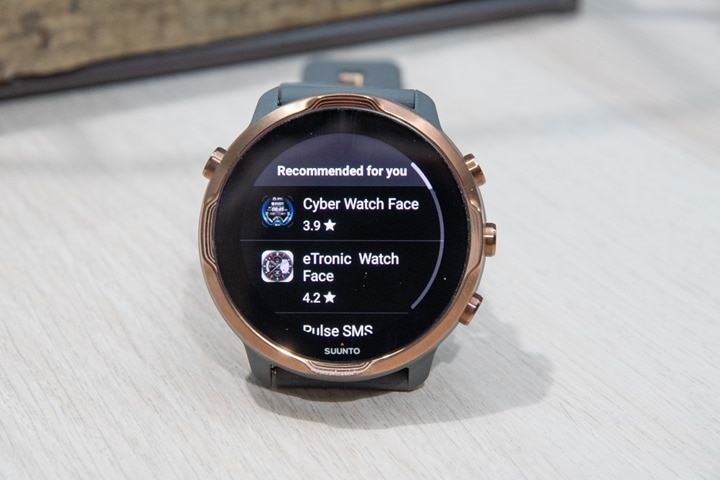
Next, watch faces take us right into the display. By default it’s not always-on, which means that as the display is black/blank all the time, unless you turn your wrist towards you. At which point it illuminates:
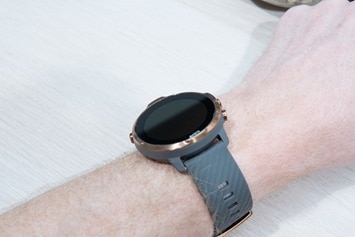
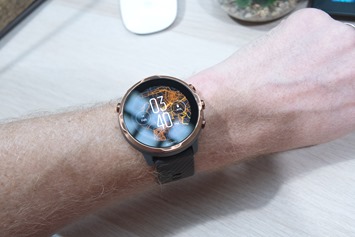
For the most part, almost every AMOLED display watch manufacturer in 2019 switched to always-on screens for their watches. And while Suunto can do so, it can be a pretty significant hit to battery life (more on that in the battery section though). In terms of brightness though, the screen is easily readable inside and outside, crazy bright sunny weather (like skiing on a bluebird day), or indoors in the pain cave. In fact, I’d argue it can often be too bright (primarily at night). Still, not going to complain here on brightness. And again, I’ve got an entire section on battery stuffs down below.
If however, you want to poke at settings for the watch, you do so by swiping down from the top:

Meanwhile, hitting the upper left button will crack open the apps launcher allowing you to start apps that you’ve downloaded (or are pre-installed):
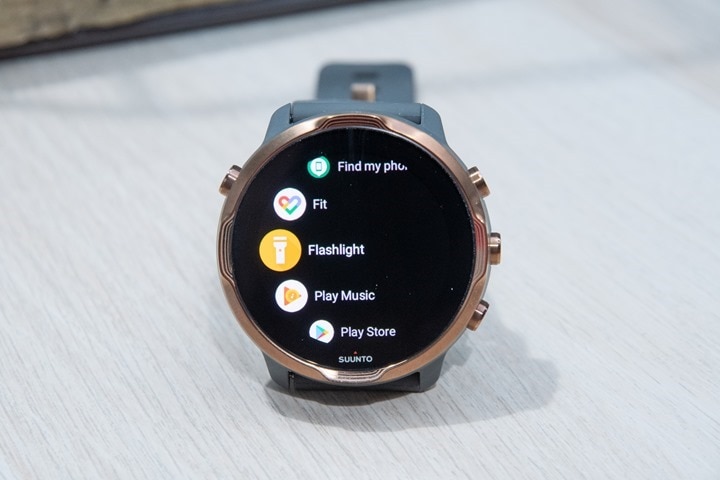
It’s here you can open up the Google Play Store and install apps directly from the watch. This is notable, as no phone interaction is needed here to browse/install apps.
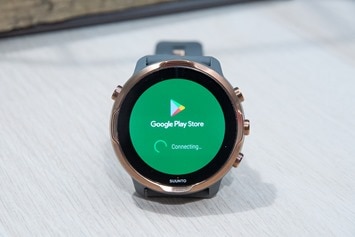
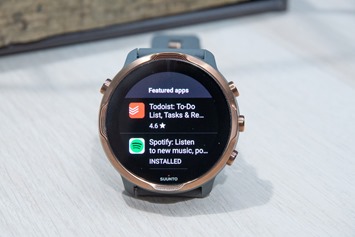
Meanwhile, if you swipe from the bottom of the watch you’ll get access to your smartphone notifications. These can include any apps that your iOS/Android phone receives notifications on.

Now this is one area that we see a significant differentiation on between iOS and Android users. For iOS users, you can’t reply back to text messages here. Instead, you can only swipe to clear (or open for more details, depending on the message). Whereas for Android users you can reply to messages.
This isn’t a Wear OS limitation though, but rather an Apple one, and applies to every watch except the Apple Watch. Apple locks down the ability to respond to text messages to only Apple Watch users.
The other catch I’ve seen is that sometimes you’ll just get this message:
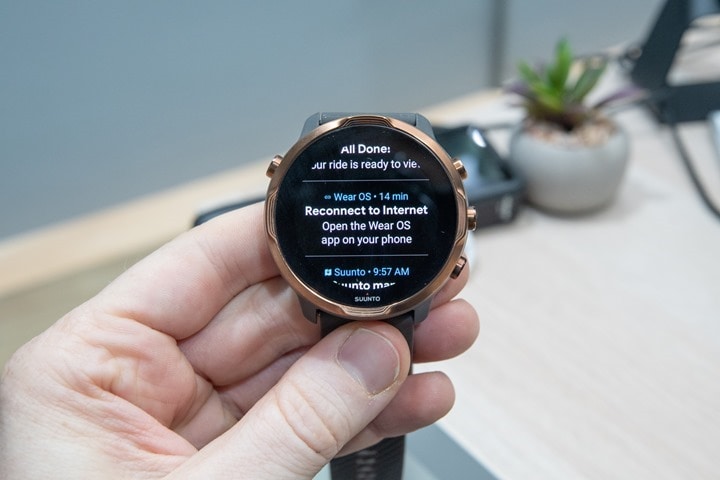
This appears to happen more commonly after a workout, where the Suunto 7 forgets its friend the phone and needs to reconnect. See, you’ll have two apps on your smartphone:
The Wear OS App: This is where you pair up the Suunto 7 to your phone, and control basic settings
The Suunto Smartphone app: This is where you’ll look at workout history and pretend to look at daily activity history.
The constant reconnections are a big deal, but if you’re used to having notifications on your wrist with perhaps your phone not in your pocket – then you might not realize you’re missing out on the latest Instagram influencer pic.
Moving along to more important things: Daily activity data.
And this…this is where things get ugly.
See, part of the appeal of Wear OS to watch manufacturers is to offload underlying feature sets to Wear OS, and one of those features is daily activity tracking. Stuff like steps, distance, calories, etc…
And indeed, at first glance Google does that via the Google Fit app:
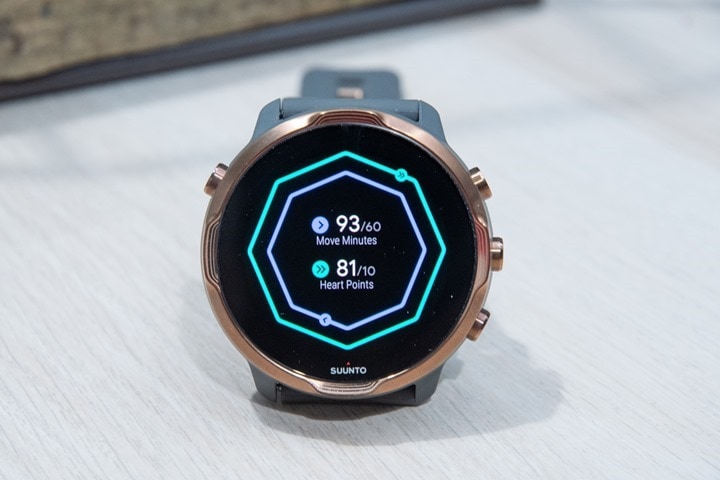
Within that app you can dive down and see things like daily steps and distance quite easily:
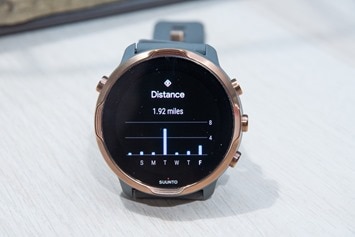
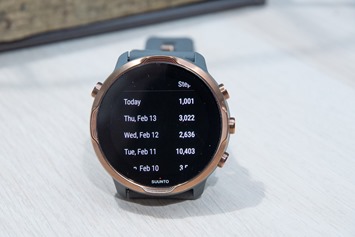
And, you can see your resting heart rate too:
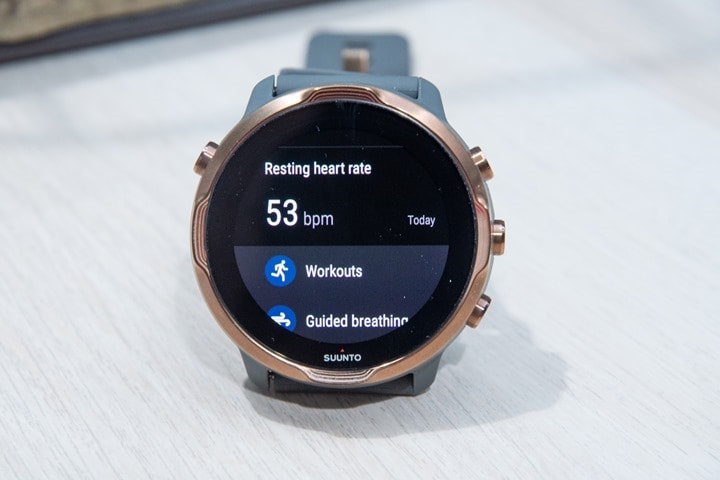
Except one (of many) catches: That resting heart rate data is only taken once every 15 minutes – an eternity by modern watch standards where almost every company out there takes readings constantly at 1-second intervals. Apple, Fitbit, Garmin, Polar, everyone. Heck, even Samsung. Samsung!
And while you can then display this data within the Google Fit app on your smartphone, it’s horribly shallow. No doubt we’ll see Google’s acquisition of Fitbit dramatically improve this in the coming year, but today the stats here are less detailed than most $ 30 activity trackers on Amazon provide.
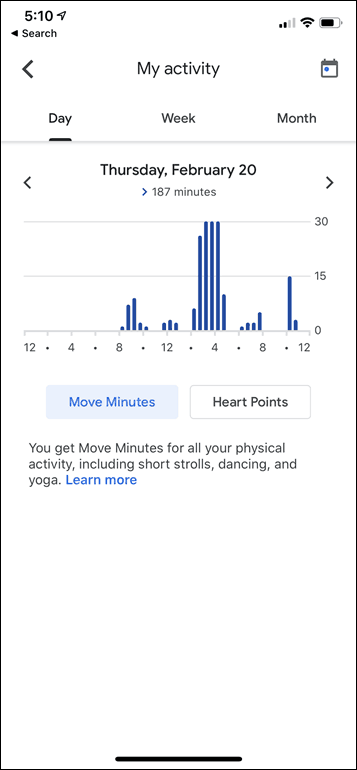
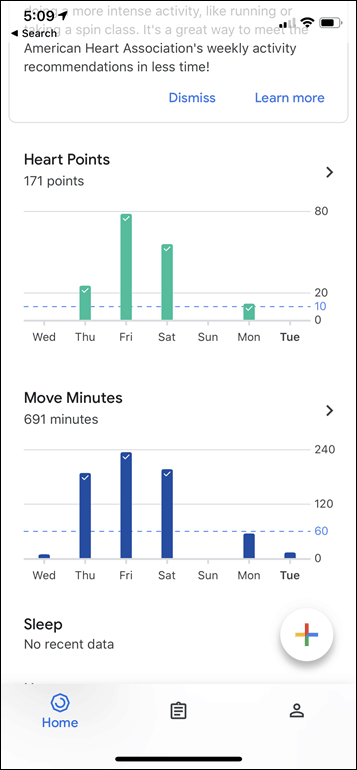
But no big deal you say – we’ll just use Suunto’s own smartphone app instead to view those stats. After all, Suunto has a longish history in daily activity tracking from all their other watches. Not to mention they’ve already got that built into the Suunto smartphone app for said watches. So, let’s crack that open:
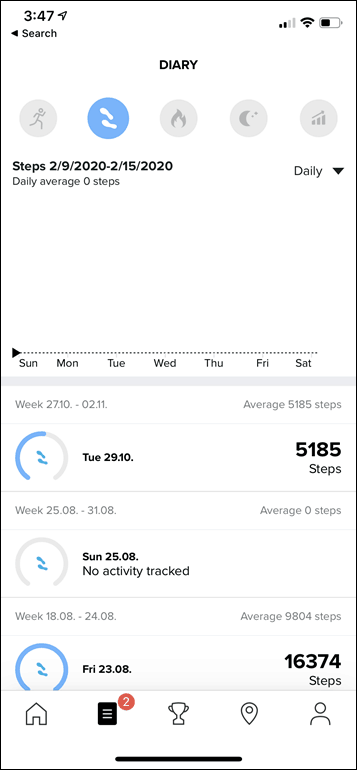
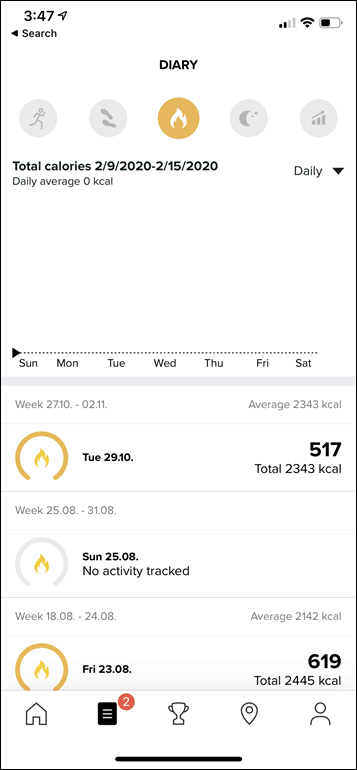
Oh.
Right.
It’s empty. Yes, for real.
No daily activity data flows from the Suunto 7 to the Suunto smartphone app (or the rest of the Suunto ecosystem). No steps, no sleep, no distance, no daily fitness level tracking…nothing. Every section you see in the upper portion of the app is empty. You’ll see numbers in the lower portion – but that’s just from other watches from last fall (if you look at the dates).

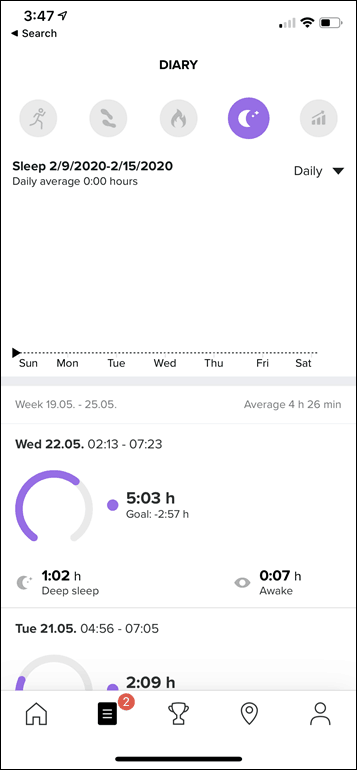
This is mind-boggling.
A core (if not significant) reason you buy a watch from Suunto specifically is for sport and fitness tracking. And while we haven’t got to the sport bits yet, the fitness side is completely empty here. I can’t overstate this enough – it’s unacceptable that Suunto as a fitness company hasn’t done the work to connect these two pieces yet. Can you imagine what people would say if Apple or Garmin didn’t bother to connect the daily steps data to their respective activity apps? People would riot in the streets.
Oh, speaking of things you can’t do: Sleep. No, you can’t do that either.
The Suunto 7 doesn’t record sleep by itself. Nor does Wear OS. Instead, you’ve got to download a 3rd party app and then you’ll get sleep data within that app (but not within the Suunto ecosystem). Again, this isn’t just a $ 99 watch here, it’s a $ 499 sport and fitness focused watch that is somehow missing core health and fitness functionality for any watch released in 2020 (or the last five years).
One last thing worth mentioning is you can add two Suunto-specific tiles to your configured screens. These show up if you swipe from the right. This includes a Suunto ‘This week’ overview, as well as a monthly view. This is also where you can add/customize some of the same Google Fit metrics we saw earlier within the Google Fit app.
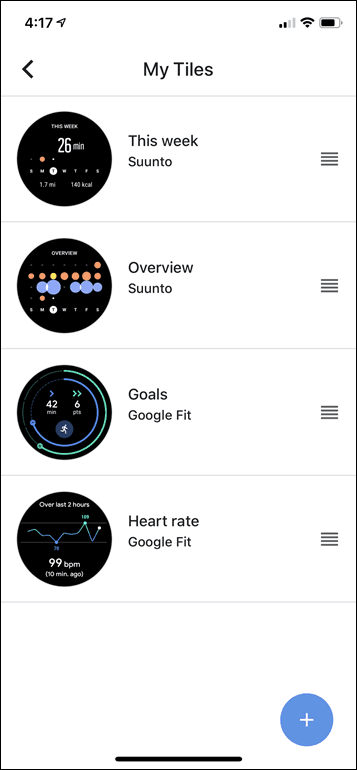
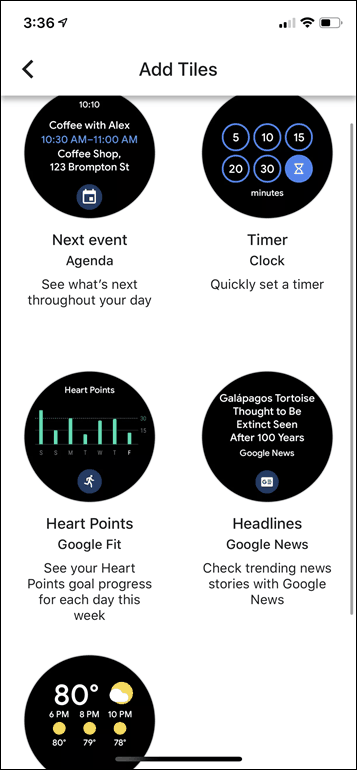
It offers an easy glance at the last week, from a completed sports workout standpoint.
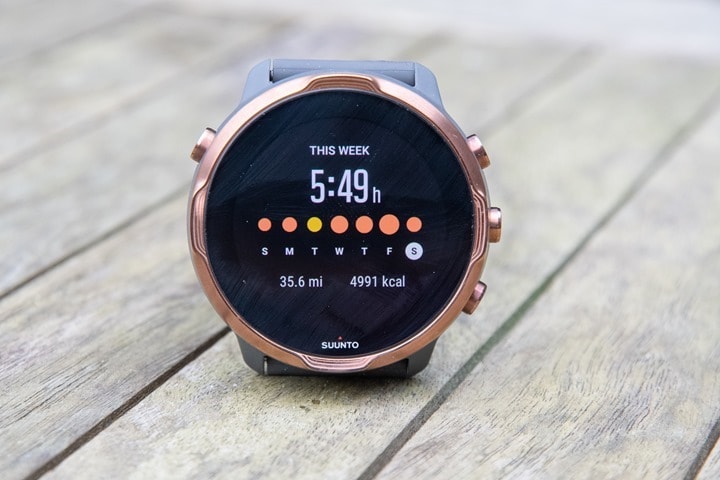
Ok, with that, onto exactly that section.
Suunto Sports App:
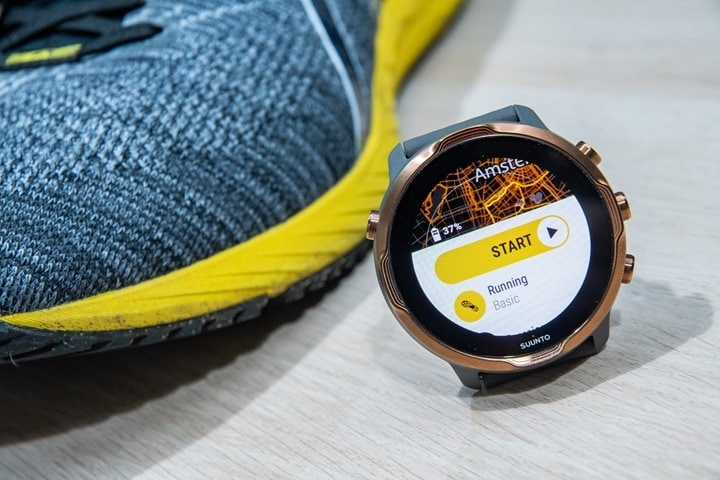
Now that we’ve got the basics out of the way, let’s dive into the sports side of the watch. This is entirely housed within the ‘Suunto App’. I realize this could be a bit confusing, since there’s a few different ‘Suunto Apps’:
Suunto App – On Wear OS: This is the app on the watch to record workouts
Suunto App – On iOS/Android: This is the app on your phone, to see those workouts
Within the bounds of Wear OS, Suunto has essentially taken their regular Suunto sport watches and rolled it into a singular app called the ‘Suunto App’. That’s where you’d start a run, go for a ride, or look at your sport history. Programmatically it’s no different than opening the Spotify or Strava apps on the watch.
Beyond that one app, there is both a few widgets and watch faces that Suunto has added, but almost all of Suunto’s work-effort here is within the Suunto app. To open said app, simply tap the upper right button, which brings you here:
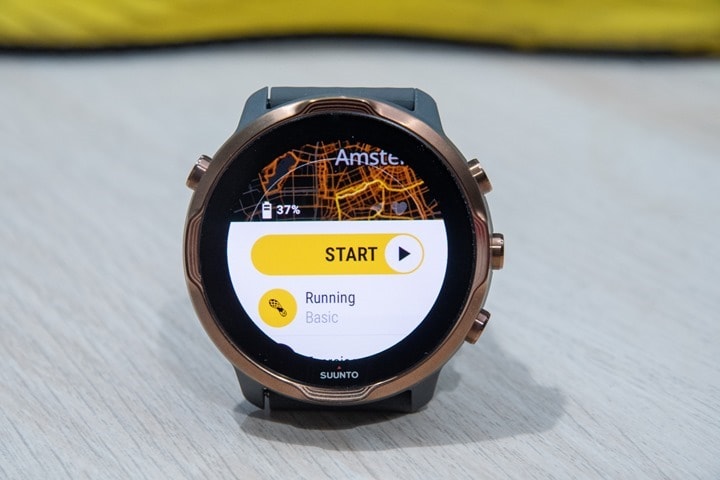
You’ll see above the heatmap for your current area, the battery percentage, as well as the sport mode you’ve selected. There are boatloads of sport modes, probably 60-80 of them or so I’d guess. For the Suunto 7 these sport modes largely tweak the data fields shown as well as calories burned. They also specify whether GPS is on or off.
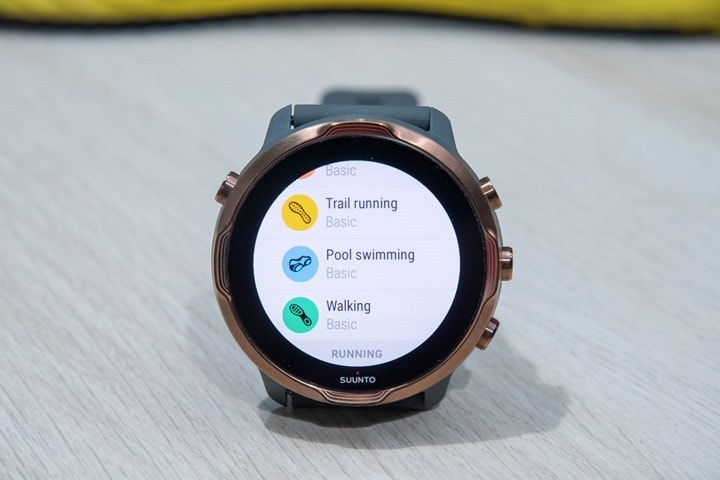
This reason this is notable is there is *no way* to modify, customize, or otherwise tweak any of the data fields/screens. You get what Suunto gives you – that’s it. I can’t remember the last time I tested a sport watch from any company that didn’t allow you to tweak some of the data fields.
You do have a handful of sport-specific options though. For example, under ‘Exercise Options’ you can toggle on/off vibrations, as well as set the screen to be always on.
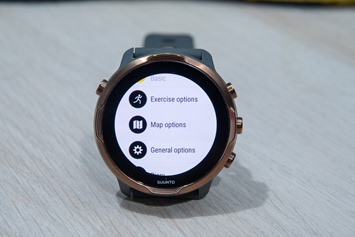
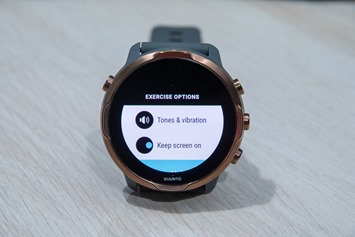
I strongly recommend using the ‘Keep Screen On’ screen option for most workouts (especially running or cycling), because there’s a substantial delay otherwise when you raise your wrist until you get the actual data shown. See without that you’ll have to wait for the watch to first turn itself on, then again to actually show numbers within the Suunto app (it’ll be empty otherwise). If it sounds silly, it’s because it is. Also, the gesture recognition isn’t great during workouts, so again, just set it to keep it on. Though, you have to set it each time to do that.
Next are the map options. This allows you to change the maps that are shown for outdoor GPS activities. Most notable here is the inclusion of heat maps. So within this you can not only change the map type, but change the heatmap overlays to be something unique like downhill skiing or even swimming. It’s super cool.
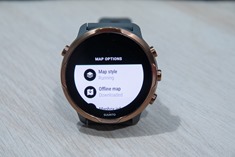
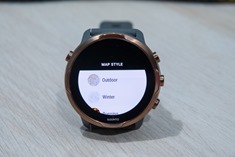
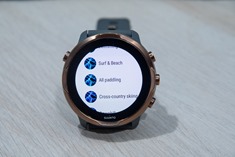
What’s less cool however is the actual downloading part. It’s a mess.
In theory you zoom around and then download the chunk of map you want. Sounds good so far. But then you need to ensure that you’re both within range of WiFi as well as on the charger. Ok, less than ideal – but again, let’s pretend that works.
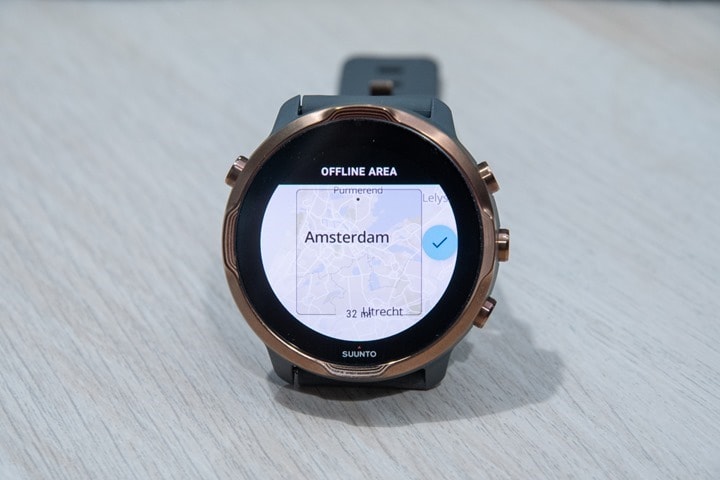
In reality, most times nothing happens. Most times you wait and it says maps are ‘pending’. For hours. Then randomly, it’ll download something. I’ve travelled a bunch in the past few weeks, and the vast majority of the time I didn’t have maps working on the first workout of that locale because it simply wouldn’t get downloaded.
If the entire point of having maps is to explore the local area – then they should work seamlessly every time.
Speaking of maps, note that there’s *NO METHOD* to download routes to the Suunto 7 at this time. While this was planned back at CES, it’s not there today and Suunto hasn’t published any roadmap information on when (or if), it’ll happen. As such, you’re left with navigation functionality (or ‘Adventure’, as Suunto would say), that’s less functional than any GPS watch they’ve ever made.
Also – it’s notable that the Suunto 7 doesn’t support *any* external sensors, at least within the Suunto app. Not chest heart rate straps nor cycling sensors nor footpods, and certainly not cycling power meters. Some will immediately respond back that “Wait, that’s the power of Wear OS, you can use 3rd party apps!”. And sure, there are but a handful that support sensors. But most have extremely limited sport profiles, even more limited connectivity to 3rd party platforms, and are often somehow even more poorly supported. After all, many 3rd party major companies (like RunKeeper) have stopped developing their Wear OS apps. I don’t believe Strava has updated theirs in over a year.
Further – there’s no multisport mode here for triathletes.
Anyway, once you’re ready to start your workout, you’ll go back up and tap/swipe to start, which then starts recording. Note that it’ll show both a heart rate and satellite icon illuminated (and not blinking), when it acquires both. I’ve found acquisition of both pretty quick.
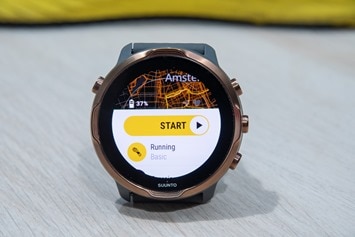
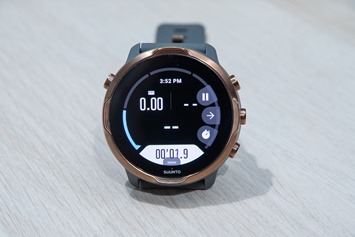
Above you can see (at right) one of the couple of data pages that are available within the running mode. This shows me distance, pace, time, and heart rate. You can pause or take laps at the bottom. Or, change to a different page. Along the upper edge is your heart rate zone in various colors.
The next page shows your lap splits, which if you didn’t press any manual laps are automatic lap splits. The automatic lap splits aren’t customizable, and vary by sport. For outdoor riding in a statute configuration they’re every 5 miles. While indoor riding they’re every 10 minutes. Outdoor running every mile. And so on
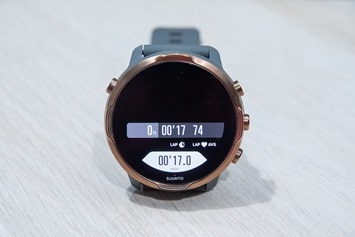
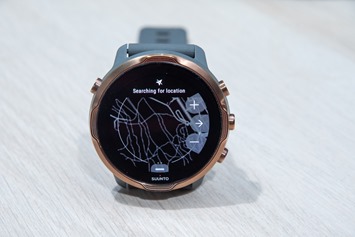
As far as running pace stability, I’ve found it fairly reasonable and didn’t seem to waver too much.
Once you’re done with the workout, you’ll go ahead and press the upper right button to pause the workout, as well as then again to end it. I do appreciate here that I can pause the workout and still see the data pages if I want to.
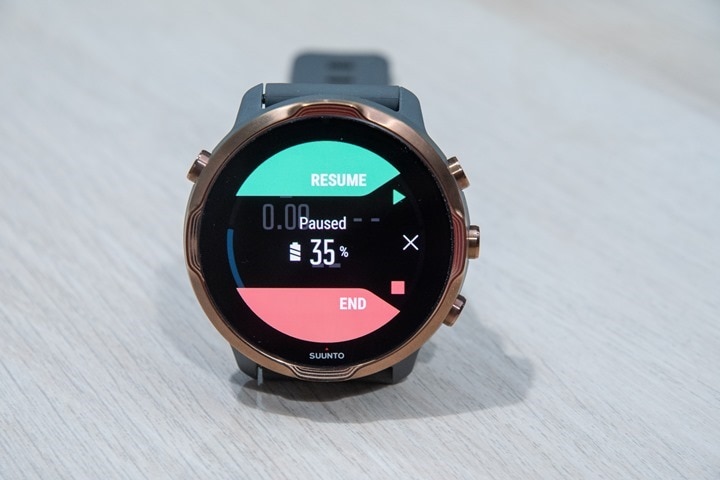
After ending the workout you’ll get a summary screen with a pile of stats:
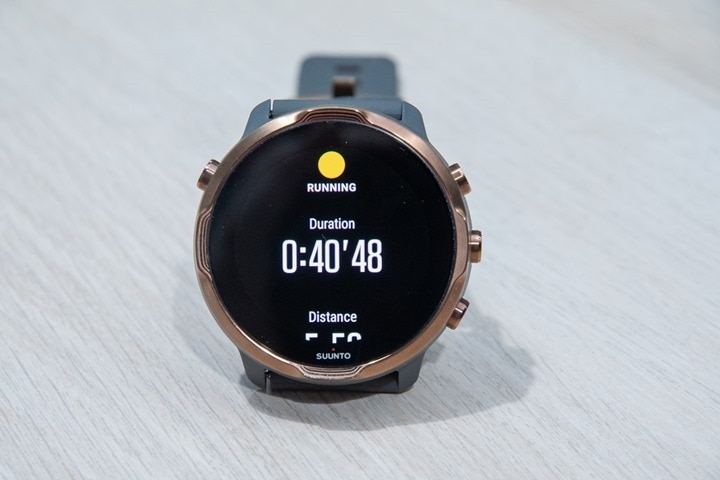
Here’s a quick gallery of those:




However, at the bottom you’ll find Recovery Time, PTE, and EPOC. It’s worth noting that while these are the same metrics seen on other Suunto watches, in this case they don’t come from FirstBeat like previous watches. Instead, Suunto is doing their own algorithms on these metrics.
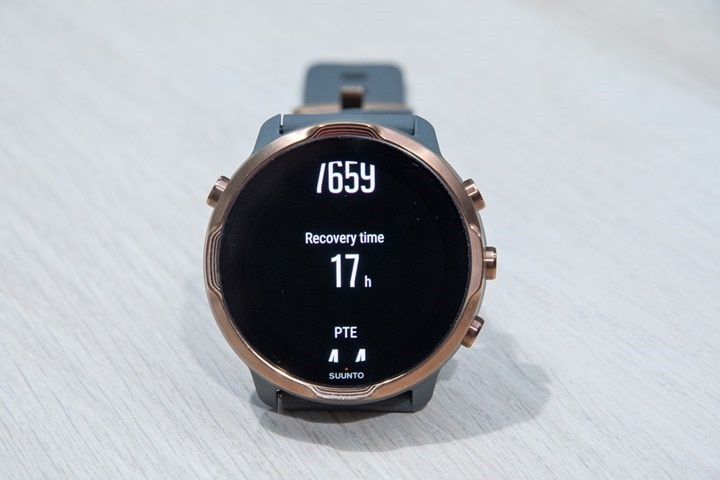
I don’t actually have a substantial issue with this per se. My issue is more simplistic: Why on earth aren’t these graphed anywhere?
Again, unlike other Suunto watches, there’s no app-based graphing of any these three metrics over time. I can’t see my recovery/load trends anywhere. This is super basic stuff that every sports-focused watch has, but not the Suunto 7.
Speaking of the app, after the workout is completed you’ll sync it to the Suunto smartphone app. In theory, this might happen behind the scenes automatically, but practically speaking, it almost never does. You usually need to re-open the app up, poke a bit, and then it goes. Once it does though it syncs it over. Note you’ll need to ensure that the Wear OS App (at left) and the Suunto App (at right) both show connected in order for this to work.
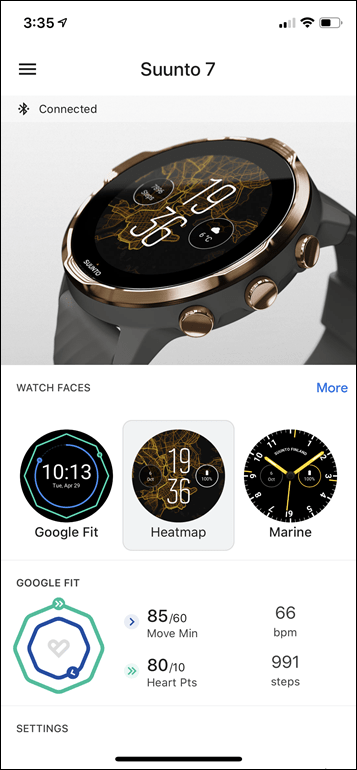
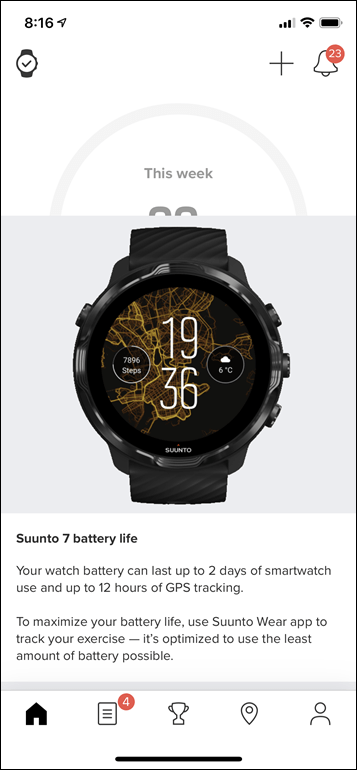
Once the watch syncs, you’ll see your workout within the Suunto app for basic analysis (note: This is not Movescount, that’s being retired).
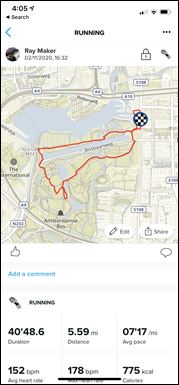
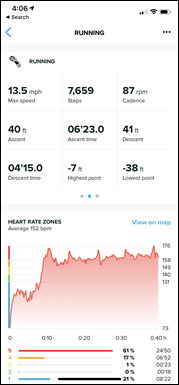

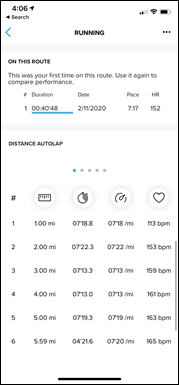
In addition, if you’ve got any 3rd party platforms setup, then it’ll send the files to those platforms as well. These can be platforms like Strava, TrainingPeaks, Endomondo, and so on.
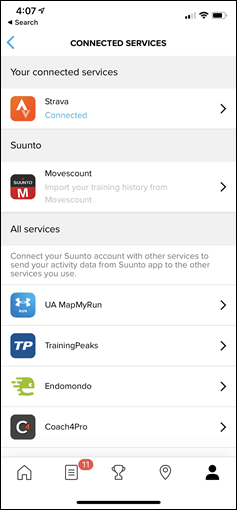
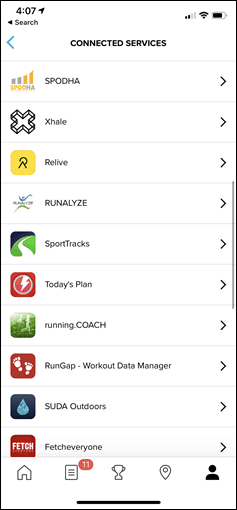
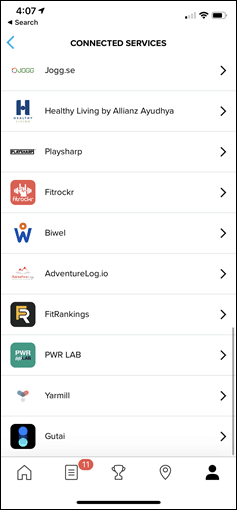
With that – we’ve covered all there is to cover about the Suunto 7 from a sport standpoint. Which, in my opinion is a problem for a $ 499 watch. If this was a $ 249-$ 299 watch, maybe (only maybe) would it be acceptable. But let’s take a look at how Suunto has named watches:
Suunto 3 ($ 199): Basic GPS-less watch for activity tracking
Suunto 5 ($ 329): Do it all GPS watch without a barometric altimeter (multisport/sensors/routes/etc all in there)
Suunto 7 ($ 499): Wear OS watch with less functionality than Suunto 3
Suunto 9 ($ 599+): Do it all GPS watch with everything including barometric altimeter in certain models
The above makes it super clear. Now, I’ve seen some arguments that say that the point of Wear OS watches is to allow apps to fill in the blanks. And that might be true for a $ 199 Wear OS watch, but not a $ 499 one. For example, here’s all the apps I would need to just get me to the Suunto 5 level:
Sleep tracking: Download an app for that
Configure my own sport screens: Download an app for that
Sensor support during workouts: Download a different app for that
Follow a route: Also download an app for that
Structured workouts (e.g. intervals): Download an app for that too
At which point I ask myself: Why exactly did I buy this watch from a sports and fitness company if I need to buy and then put together a hodgepodge of different apps?
Music:
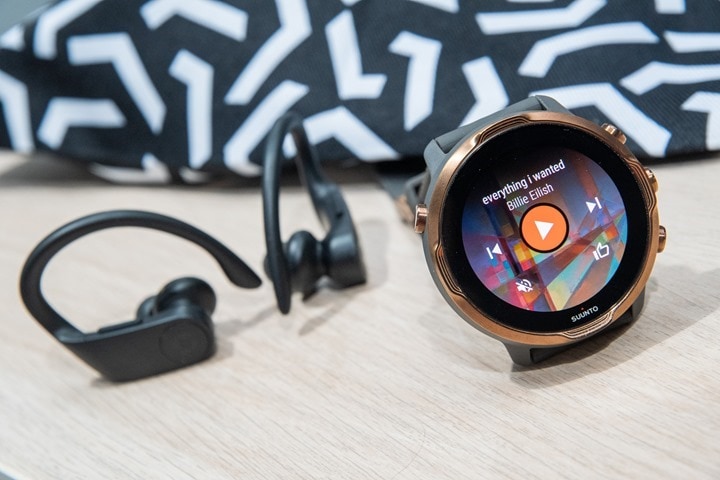
One of the reasons you might buy the Suunto 7 over something else could be music. Or maybe payments. But I can’t show you payments as I’m not currently sitting in one of the supported countries. So we’ll focus on Music for now and the next time I’m travelling to one of the supported countries I’ll add a payments section in.
The Suunto 7 supports two core music types:
A) Streaming platforms (like Google Music or Pandora)
B) Manually loaded music (like MP3’s or such)
Because it’s 2020, I’m mostly just going to focus on streaming platforms. I think that’s how the vast majority of people are getting music on their wearables these days (if for no other reason than manually loading music to most watches is a pain in the butt).
In my case, I’ll use Google Play Music to demonstrate things, though for the most part it works relatively similarly across all music services. Note however that not all music services support offline streaming, even if they have an app. For example, Spotify as a Wear OS app – yet you can’t download music to your watch. Instead, it just controls music on your phone. Which…is mostly useless.
The first thing you’ll need to do is pair up some headphones to your watch. Any Bluetooth audio device will work, so that could also just be a portable speaker too. In my case I mostly used my PowerBeats Pro, which worked great and I got zero disconnects with the Suunto 7:
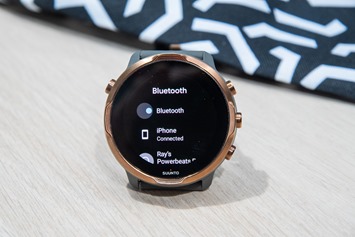
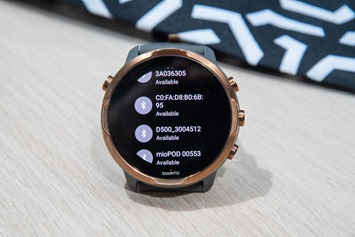
However, as a good example of the lack of polish of Wear OS (Google’s fault, not Suunto’s), you’ll notice it enumerates every Bluetooth device it sees, not just ones conforming to the audio standard. C’mon Google, even crappy car rentals from a decade or so ago know how to filter by Bluetooth device class.
In any case, once paired up they’ll automatically connect anytime they’re turned on:
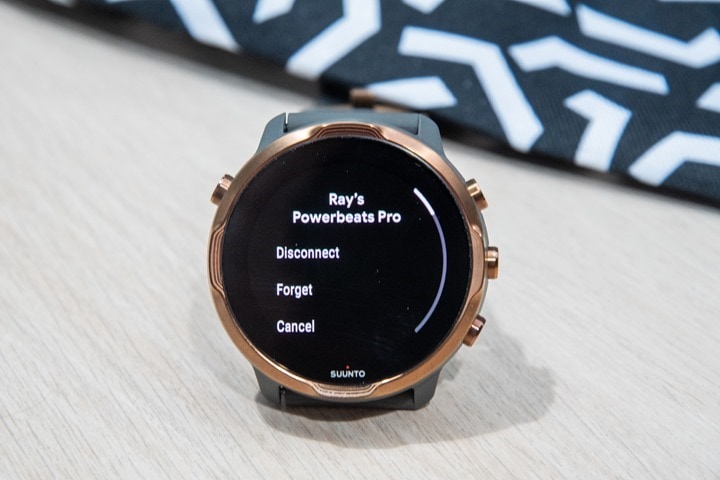
Next, if we crack open the Google Play Music app, you can see various playlists or categories. For example, there’s a ‘Music for Fitness’ section. Which, actually isn’t music for fitness at all. It’s just a random selection of non-fitness stations. For example, one time I opened it I got both a gospel station and a prayer station. I kid you not. Another time I got teen pop – which, might actually work.
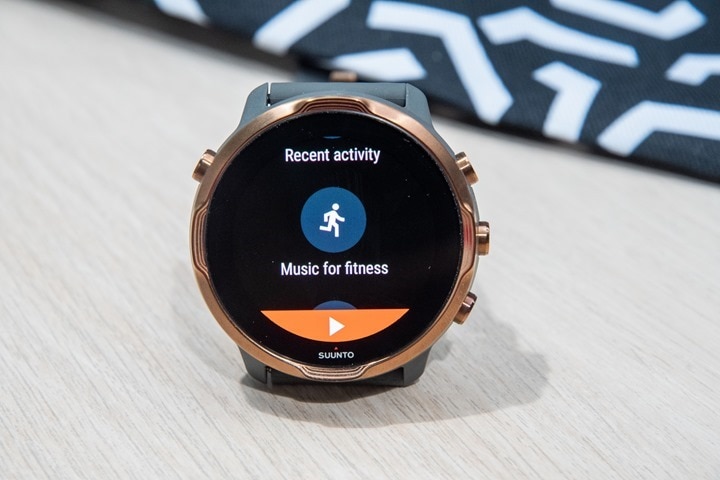
What’s silly about this is that it basically says “We don’t care” to me. So Google, here’s a tip – Fitbit (the company you acquired a few months back), actually has entire fitness playlists they put together at the time of the Ionic launch. Here’s a link to that post. Or…you know, somehow magically link the option on this watch for ‘Music for Fitness’ to the section in the Google Play Music actually already has. Left hand, meet right hand.
Of note though, you actually don’t need to download music to your watch ahead of time. That’s a notable difference to Garmin’s music platform, which requires you download before you head out. With Wear OS you can use both WiFi or cellular connectivity to listen to music.
In any event, we’re gonna download music via WiFi like a sensible human being. So I do that.
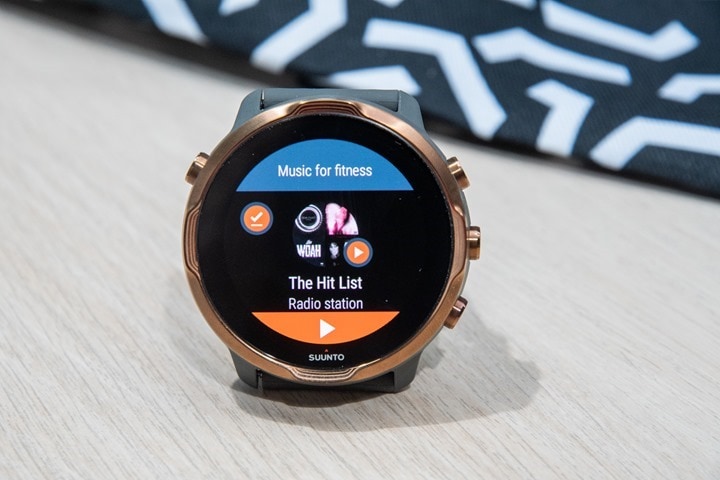
Then I simply hit play, and off I go. Look, don’t judge my music options here. It was this or gospel. And there’s nothing wrong with gospel. But the appropriate time for some gospel is the last mile of a marathon, and this moment wasn’t it.
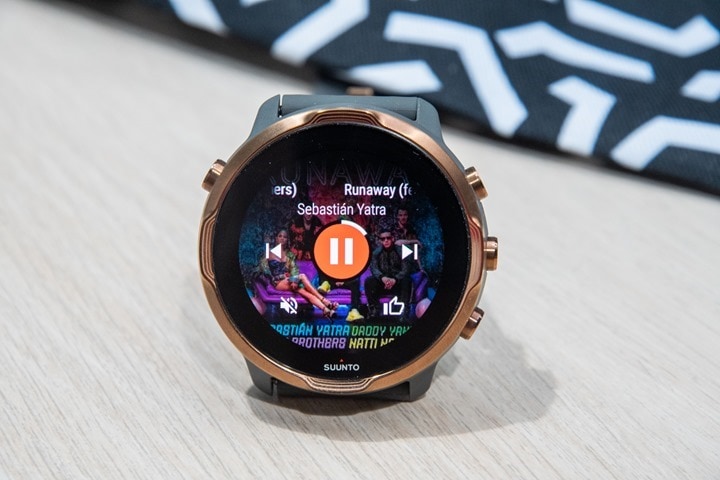
You can tweak the volume as well as skip/pause/play pretty easily from the menu interface.

Now, if you want to do a workout at the same time, you’ll just go ahead and then crack open the Suunto app (or your other sport app) and you’re off and running. Literally or otherwise.
Ignoring my somewhat teasing (and somewhat not) annoyance at Google’s aim around fitness here, from a functional standpoint the music bits work great here. Now, if only Spotify would get their app working with offline options…
Battery Life & Options:
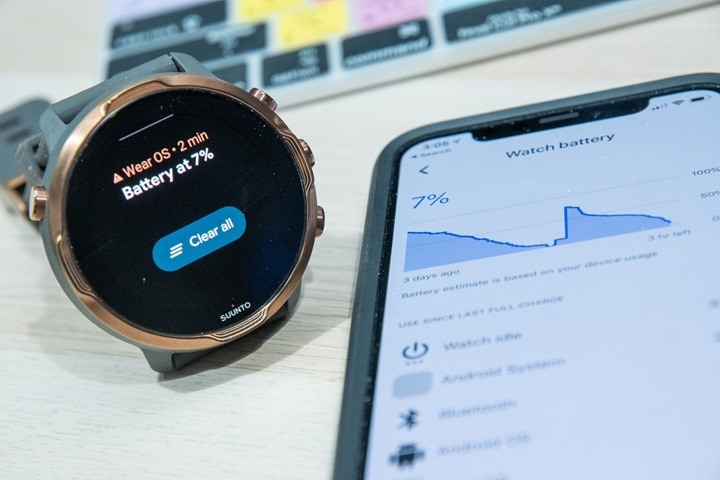
Yes, you’ll wish it was more. It’s Wear OS after all.
I’ve been carefully tracking my battery life daily with the Suunto 7, and some relatively clear patterns have emerged. To begin, the first 24 hours after you get it set up are a complete inferno of battery burn. This was (apparently) true back at CES when I tried a prototype, but also true for my retail production unit. You likely won’t finish the day, depending on what time you set it up and what other activities you might do. However, it does get slightly better after that.
In general, you’re going to get about 20-28 hours of standby watch battery life if using the default settings on the Suunto 7 – with a typical 1hr workout each day. That means the screen is off unless your wrist is turned (also, I configured my screen and notifications to be entirely off at night so it wouldn’t turn on with any random movements). So you’ll be charging it once per day.
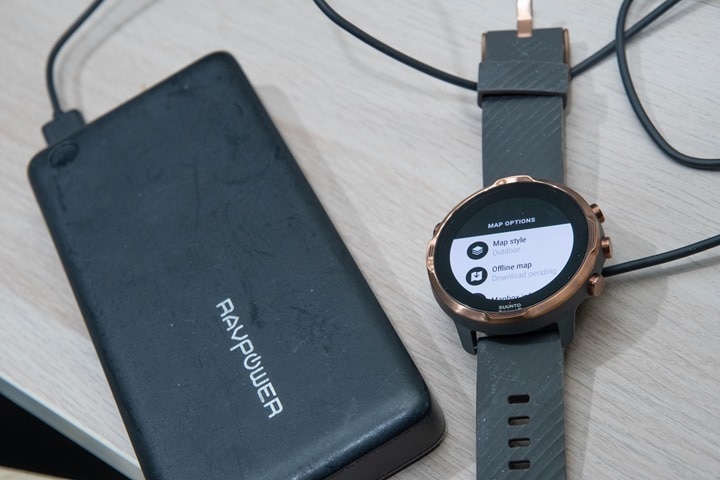
At first you might argue that’s like an Apple Watch Series 5. And that’s true – it’s roughly in that ballpark. However, the Apple Watch Series 5 has an always-on display, whereas the Suunto 7 has an always off display. The Apple Watch Series 4 would be a more valid comparison, but the battery life there is an easy 2 days, if not edging into the 3rd day.

From a notification standpoint, I had normal notifications enabled, which on average meant 2-3 notifications per hour over the course of the day (less in the morning, more in afternoons/evenings).
Each night when I went to bed I’d manually turn the display off (swipe down, select the bottom left button). I’d also enable do-not-disturb mode manually when I went to sleep. So this would significantly cut down on battery burn. I left 24×7 activity tracking enabled, which meant that the watch samples your heart rate approximately every 15 minutes, briefly. Note that virtually every other company on the market samples at once per second. Meaning the Suunto 7 samples your heart rate 1/900ths as often as the competition.
During GPS activities and indoor workouts I used the default Suunto app almost exclusively. I found this burned the battery at quite variable rates, which was surprising to me. To summarize some three weeks worth of workouts thus far:
A) Outdoor GPS runs: These seemed to be about 10-15% per hour battery burn (no music, generally no phone nearby)
B) Outdoor GPS cycling: These burned anywhere from 15% to 20% per hour
C) Indoor non-GPS workouts: These typically burned about 10% per hour
D) Outdoor GPS skiing: These burned 25-30% per hour
I’ve got numerous samples of each one. And both always-on and not always-on display. In most cases I found the always-on display option for workouts actually didn’t massively change the battery burn. Oddly, it almost seemed like speed actually. I could keep trying to figure out why certain workouts (like skiing and cycling) resulted in a far higher battery burn rate, but honestly, it seems like it’s a game of whack-a-mole.
One only need to look at the Suunto forums (for the Suunto 7) to see that everyone is getting wildly different battery burn rates – even in a default configuration. I’ve yet to see any post from anyone that supports Suunto’s claims of getting 12 hours in GPS mode and 30 hours in indoor workout mode.

Next, there’s a feature called ‘Battery Saver’. This is very similar to what we see on the Casio smart watches (and a few others), which puts the watch into a low power state that has *no* smart functionality, merely just the time/date on a watch-face. The Suunto 7 will by default start offering this mode to you when under 10% battery life. This is what it looks like:
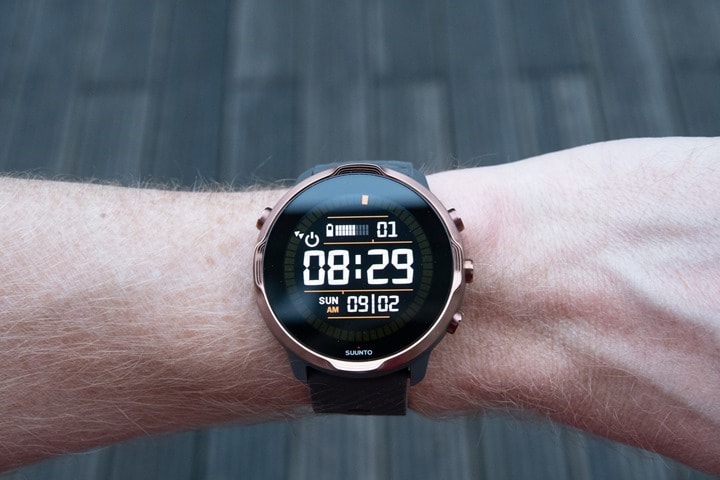
But you can also manually go into this mode by swiping down from the upper menu and then simply taping the battery icon. After that, it’ll confirm that’s what you want to do.
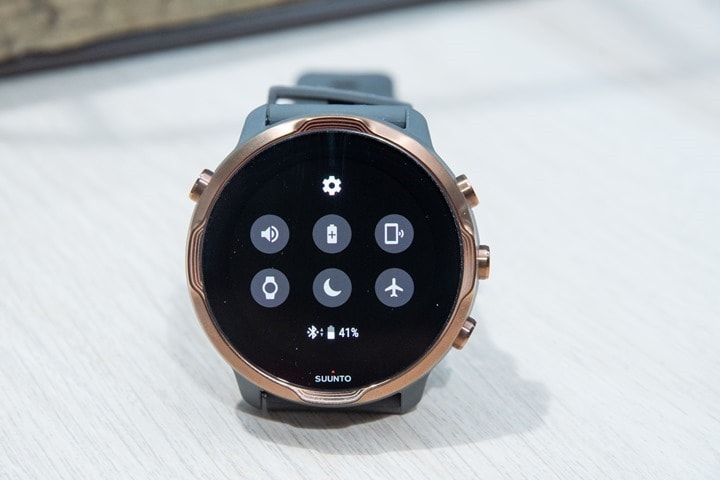
While this, in theory, gets 40 days of battery life, in practice once if you find yourself in this mode it’s because you probably let the battery get to 3% when it forces it over to it. So yes, it’s useful if all you need to know is the date/time (such as…being stranded in the middle of the Sahara desert without a USB battery bank for your phone). But since the point of buying a smart-watch was to have smarts, in practice this isn’t a super useful function.
It’s worth noting that none of the battery issues are meaningfully fixable via software updates. It’s a long-standing Wear OS problem, in large part because Google specifies the exact manufacturing partners (and in turn, chipsets) that companies must use for Wear OS watches. The Suunto 7 is based on the Qualcomm Snapdragon Wear 3100 processor, which was already behind the competition when it was announced. The next ray of hope is the Snapdragon Wear 3300 processor, but there’s no timeline of that, and even the most optimistic of timeframes says late 2020 (and that was pre-Coronavirus), with more realistic estimates putting it into 2021 sometime. However, I could see a scenario where Fitbit’s extra leverage could force Google to lean heavily on Qualcomm to have products in place for the Fall 2020 holiday season (when Fitbit typically releases new products).
Ultimately though, none of that will help the Suunto 7, which simply isn’t ideal for any form of long term workouts or such.
GPS Accuracy:
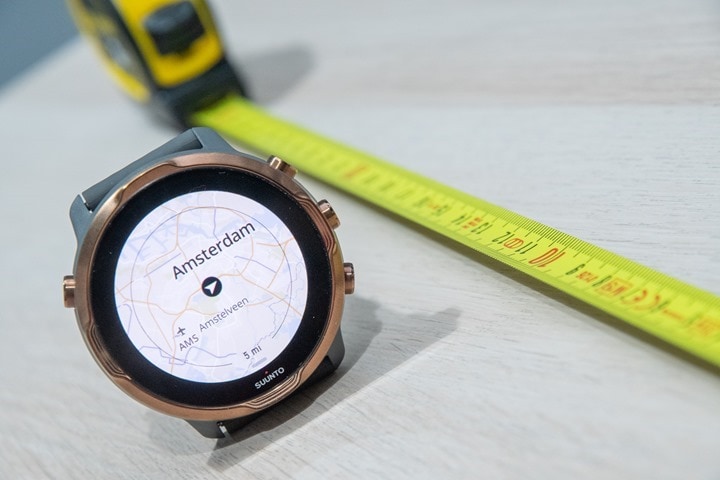
There’s likely no topic that stirs as much discussion and passion as GPS accuracy. A watch could fall apart and give you dire electrical shocks while doing so, but if it shows you on the wrong side of the road? Oh hell no, bring on the fury of the internet!
GPS accuracy can be looked at in a number of different ways, but I prefer to look at it using a number of devices in real-world scenarios across a vast number of activities. I use 2-6 other devices at once, trying to get a clear picture of how a given set of devices handles conditions on a certain day. Conditions include everything from tree/building cover to weather.
Over the years, I’ve continued to tweak my GPS testing methodology. For example, I try to not place two units next to each other on my wrists, as that can impact signal. If I do so, I’ll put a thin fabric spacer of about 1”/3cm between them (I didn’t do that on any of my Suunto 7 activities however, all workouts only had a single device per wrist). But often I’ll simply carry other units by the straps, or attach them to the shoulder straps of my hydration backpack. Plus, wearing multiple watches on the same wrist is well known to impact optical HR accuracy.
Next, as noted, I use just my daily training routes. Using a single route over and over again isn’t really indicative of real-world conditions, it’s just indicative of one trail. The workouts you see here are just my normal daily workouts. For this time period that includes workouts in Amsterdam (and surrounding area), as well as down in the Alps along the France/Swiss/Italian border. While I also tested it briefly in Las Vegas on a run too, I won’t include that prototype data here.
First up we’ll start with something relatively easy, a meander through the Amsterdam Bos (forest/park area). Here’s that data set, compared against a Garmin Fenix 6S Pro and Polar Vantage V:

While the Suunto 7 got GPS lock immediately outside, I had stupidly decided to take a fresh out of the box Garmin Fenix 6S Pro, which apparently hadn’t finished downloading its GPS satellite cache yet. So, I waited quite a while for that, and in turn, you can also see the supposed impact of that to the Fenix 6’s track. Mind you, I don’t think that’s acceptable – once I have GPS lock it should be good no matter the cache. But anyway, FYI.
As you can see below, the Suunto 7 and Polar remained fairly close together, while the Garmin Fenix 6 was semi-drunk nearby most of the time.

Which definitely shouldn’t be interpreted as the Suunto 7 being perfect, cause it wasn’t. For example below you see it and the Garmin taking turns meandering off in the woods. Didn’t their parents tell them that’s where bears and wolves eat small children?

But for the most part the Suunto 7 was fine. Not great, but not bad either, just fine. Acceptable you could say.

Next, let’s up the ante and look at a track workout. This time with a similar set of players, though swapping out the Fenix 6S Pro for a Fenix 6 Pro. Because I found it in my bag. Also fresh off spending months in a drawer, but seemed to be happier. Here’s that data set.

On the first portion heading along a straight-shot bike path, the Fenix 6 was slightly offset, but the Suunto 7 and Polar units held the line.

Once at the track, the Suunto 7 (in green) was mostly on the track for most loops. However, for both the entrance and exit to the track, it went where I didn’t. Also, you’ll see that near the taller building in the lower right (Olympic Hotel Amsterdam), it plotted a couple of wonky lines on that side of the track. Again, nor horrible in the grand scheme of things, but not amazing either.

On the way to the track I did a loop around Olympic Stadium, and that was a perfectly acceptable performance by the Suunto 7:

And while the Olympic Stadium loop was correct, the section out on the main road wasn’t. Here both the Suunto 7 & Polar Vantage V were off in some buildings, while the Fenix 6 was pretty close to the path I was on:

While I’m doing slightly less outdoor workouts in the winter right now (and more indoor workouts), I’ve been using my daily bike commute each day to test the GPS, varying it slightly in both directions to see how it handles buildings, bridges, and obstacles. And by and large it’s perfectly fine.

It’s spot-on the bike path virtually every ride. All is good there.
And that same accuracy level seems to extend to outdoor riding workouts too. For example this one I did out into the countryside one day:

It’s virtually spot on with the Stages Dash L50 and the Garmin Edge 830 the entire time. Zero issues.

So much so that it’s pretty boring looking at GPS tracks of it:

I also used it skiing too all last week, 1-2 sessions per day (morning and then later again in the afternoon). And while it burned battery like a blowtorch, it accuracy-wise seemed pretty darn solid for all my ‘workouts’. I can’t complain. I didn’t do as deep of testing in terms of 3-4 devices, I only had two devices, but even then, the tracks are close enough for what I’d expect, especially in the high altitude mountains of the French Alps.
So overall, from a GPS accuracy standpoint I’ve found the Suunto 7 pretty close. It’s not a Suunto Ambit for sure, but it’s seemingly just as good as a Suunto 3/5/9 is from a GPS standpoint for the places and areas I’ve tested.
(Note: All of the charts in these accuracy sections were created using the DCR Analyzer tool. It allows you to compare power meters/trainers, heart rate, cadence, speed/pace, GPS tracks and plenty more. You can use it as well for your own gadget comparisons, more details here.)
Heart Rate Accuracy:
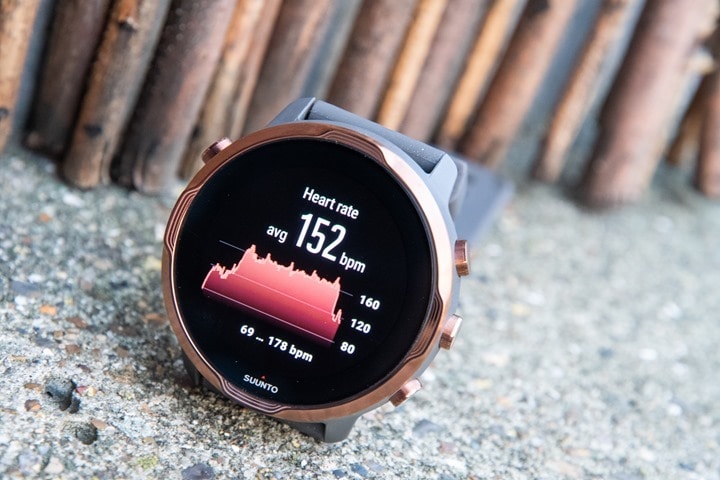
Next up we’ve got heart rate accuracy. This roughly falls into two buckets: 24×7 HR, and workout HR. Unlike virtually every other watch I’ve tested in the past few years, the Suunto 7 is completely useless for 24×7 HR monitoring. With sampling only every 15 minutes, it’s hardly useful for extracting any meaningful trends, except possibly sleep tracking. There’s a lot that one can look at holistically the entire day, but 15 minutes is just too sporadic to be of value. And that ignores how horrifically the data is displayed (only within the poor Google Fit app, not Suunto’s platform). Speaking of which, I talk about (resting HR) RHR values and 24×7 monitoring here and why it’s interesting. Here’s all you get within the Suunto 7 via Google Fit:
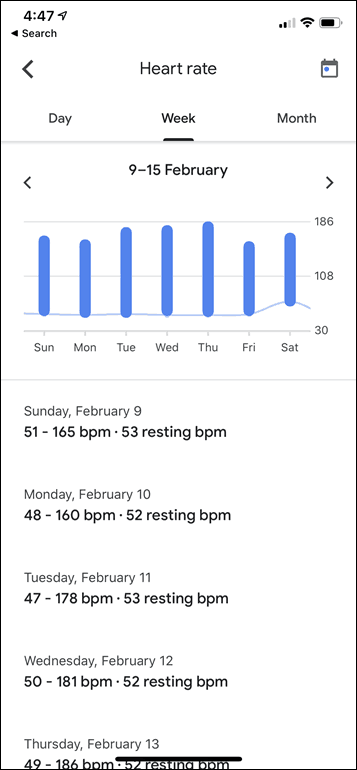
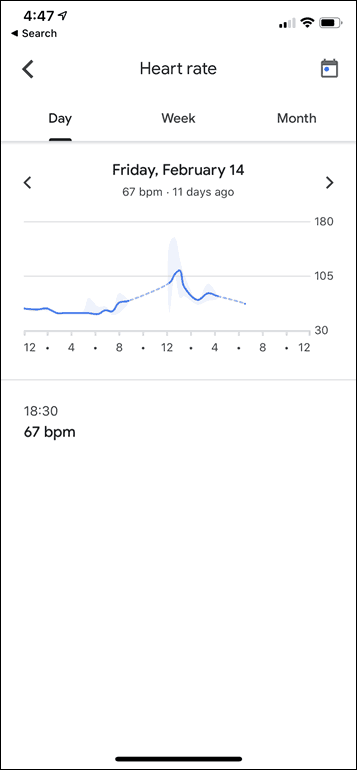
Before we move on to the test results of sport accuracy, note that optical HR sensor accuracy is rather varied from individual to individual. Aspects such as skin color, hair density, and position can impact accuracy. Position, and how the band is worn, are *the most important* pieces. A unit with an optical HR sensor should be snug. It doesn’t need to leave marks, but you shouldn’t be able to slide a finger under the band (at least during workouts). You can wear it a tiny bit looser the rest of the day.
Ok, so in my testing, I simply use the watch throughout my normal workouts. Those workouts include a wide variety of intensities and conditions, making them great for accuracy testing. I’ve got steady runs, interval workouts on both bike and running, as well as swimming – though, I didn’t focus on optical HR accuracy there.
For each test, I’m wearing additional devices, usually 3-4 in total, which capture data from other sensors. Typically I’d wear a chest strap (usually the Garmin HRM-DUAL or Polar H9) as well as another optical HR sensor watch on the other wrist (lately the Polar OH1 Plus, as well as the new Mio Pod). Note that the numbers you see in the upper right corner are *not* the averages, but rather just the exact point my mouse is sitting over. Note all this data is analyzed using the DCR Analyzer, details here.
We’re going to start with something simple here first – a casual run around the forest. This is compared against a Polar H9 chest strap, a MioPod optical HR sensor, a Polar OH1 Optical HR sensor, and a Whoop band. Lots of stuff, but no sensor near another. Here’s that data set:

In this set, the Suunto 7 is in purple. As you can see, it gets off to a rough start. Despite my test protocol for *every* activity calling for waiting an additional 20-60 seconds after it shows heart rate lock, it doesn’t seem to help in this case (spoiler: or in any other case).
If we zoom in there, we see it completely misses the boat…for the first 13 minutes:

On the bright side, after those 13 minutes, it mostly locks on. Mostly. You’ll notice roughly every 8 minutes or so I do a hard interval for about 30 seconds. You’ll see that all but one time the Suunto 7 struggled here. It’s in purple, highlighted. Mind you, the Whoop strap also struggled a little (it was paired to the Garmin Fenix 6 Pro), but nowhere near the Suunto 7:

So, let’s kick it up a notch – this time, an interval workout on the track. Pretty much the same cast of characters here, except the Suunto 7 color changed to green (to keep you on your toes). Here’s that data set:

Once again, you see it really struggles for the first 8-9 minutes. Again, I waited outside quite a long time after it found lock (about 6 minutes this time, because I’m generous). No luck.

After its initial failboating, it does seem to hold pretty steady for a while. You see that the extended warm-up was fine, and then the first two intervals were fine for the Suunto 7. These were 800m intervals at a reasonably fast past. However, the last three intervals the Suunto 7 totally lost the plot again. Despite getting the hard part correct (the start of each interval), roughly 400m into each one it would fall apart.

Finally, I did 4x200m intervals at the end, here’s how those ended up:

It got one of these correct, one horribly incorrect, one mostly incorrect, and one not good.
Now is probably a good time to point out that when it comes to optical HR sensors, I’m one of the easiest people for optical HR sensors to work on. I’ve got fair skin, I can easily place the sensor in the exact right place away from the wrist bone, my wrists don’t have a ton of hair, nor tattoos. For the most part, when an optical HR sensor fails on me – the rest of you are up crap creek.
It also helps that I know all the tips and tricks to getting the best performance out of even the worst sensors. From exact placement to tightness to how to place clothing. I tried all those tricks here – no luck.
Let’s move on, this time indoors to an indoor trainer workout on Zwift. As you can see, once again the Suunto 7 struggles at the beginning. So did the Whoop strap, but, yeah. Here’s that data set:

After roughly the 11th minute on this indoor cycling bike life stabilizes for the most part, matching the others.

I did think it was interesting to see the lag at one point on one of my sprints. You’ll notice how the Polar H9 chest strap was super responsive, then the Whoop strap lagged about 7-10 seconds. Then another 10 seconds after that the Suunto 7 finally realized what was going on – once it was basically all over.

And because I’m not sure I’ve made my point yet, here’s another indoor cycling workout. You can see how the Suunto 7 misses the boat (along with the Whoop again) the first 12 minutes.

It does seem to lock on fairly well during most of it, which was fairly stable for me intensity-wise.
However, towards the end I do some sprints, and you can see it loses the plot again:

For each of these sprints, it misses them almost entirely. It’s useless here.
Finally, just to be really sure you understand the full Monty of how bad this sensor is, let’s look at an outdoor ride:

Yup, that purple line there is the Suunto 7. Despite waiting at the beginning (as you can see for a few mins), despite waiting at stoplights. Despite waiting at windmills to take photos – it never gets onboard. Ever.
I’m not sure I need a summary paragraph for this section at this point, but just in case you skipped to the end I will. The Suunto 7’s optical HR sensor is the worst optical HR sensor I’ve tested in years, perhaps even ever. I’m struggling to remember anything worse. The company behind it, LifeQ, has made sensors before (most notably in the now-defunct TomTom series of watches), and even then they weren’t that bad. So who knows what’s up. But given the wide variety of scenarios I’ve tested it in, and given that this seems to match a number of people on the Suunto forums – I don’t think it’s a ‘me’ issue.
Product Comparison:
I’ve added the Suunto 7 into the product comparison database, allowing you to compare it against other products that I’ve reviewed in the past. For the purposes of below I’ve compared it against the Apple Watch Series 5, Garmin Venu, Suunto 5, and Samsung Galaxy Active Watch 2 – which are the ones most people will be comparing it against from a sports/fitness standpoint.
Note that with all these watches – but especially the Apple Watch with WatchOS and the Suunto 7 on Wear OS, there are many cases below where “with 3rd party apps” can be used. The same is largely true of Garmin, Samsung, and somewhat with Fitbit. But the Apple Watch tends to offload more core fitness functionality to 3rd party apps than the others. I’ve tried to thread the needle of apps that I roughly know exist where I’ve listed that. But it’s not perfection in terms of knowing every app on earth. Ultimately, I don’t think any consumer does (or should). Plus, we’ve actually seen a pulling back of wearable apps from companies over the last year (basically, they stop updating them). Making it even harder to know an up to date app from a dysfunctional one dying on the vine.
Finally, for a Suunto reality check, I added the Suunto 5 into this list. You can add the Suunto 3 or 9 using the full comparison tool. However, I say reality check because in theory the Suunto 7 should be more advanced than the 5 (but less than the 9 – that’s the whole point of this naming scheme). And, from a music/smartwatch standpoint is. However, from a sports standpoint it definitely isn’t.
Ok, onto the full chart:
| Function/Feature | Apple Watch Series 5 | Garmin Venu | Samsung Galaxy Active | Suunto 5 | Suunto 7 Wear OS Watch |
|---|---|---|---|---|---|
| Copyright DC Rainmaker – Updated February 26th, 2020 @ 10:16 amNew Window Expand table for more results | |||||
| Price | $ 399/$ 499 (cellular) | $ 399 | $ 199 | $ 329 | $ 499 |
| Product Announcement Date | Sept 10th, 2019 | Sept 5th, 2019 | Feb 20th, 2019 | May 21st, 2019 | Jan 5th, 2020 |
| Actual Availability/Shipping Date | Sept 20st, 2019 | Sept 5th, 2019 | Mar 9th, 2019 | Early June 2019 | Jan 31st, 2020 |
| Data Transfer | Bluetooth Smart | USB, BLUETOOTH SMART, WiFi | Bluetooth Smart | USB & Bluetooth Smart | Bluetooth Smart & WiFi |
| Waterproofing | 50m | 50 meters | 50 meters | Yes – 50m | 50m |
| Battery Life (GPS) | 6hrs GPS on time (18hrs standby) | 20 hrs (just GPS), up to 6hrs GPS+Music | Undeclared (claims 45hrs non-GPS) | Up to 40 hours | 12hr spec (about 4-6hrs reality) |
| Recording Interval | Varies | 1s or Smart Recording | 1-second for GPS, 1-minute for HR | Variable | 1s |
| Satellite Pre-Loading via Computer | Yes via phone | Yes | Yes | Yes | Yes (via Phone) |
| Quick Satellite Reception | Most times | Great | Yes | Great | Yes |
| Alerts | Vibration/Audio/Visual | Vibrate/Visual | Vibrate/Visual | Sound/Visual/Vibrate | Audio/Visual/Vibrate |
And again – don’t forget you can make your own product comparison charts comparing any products using the product comparison database.
Wrap-Up:
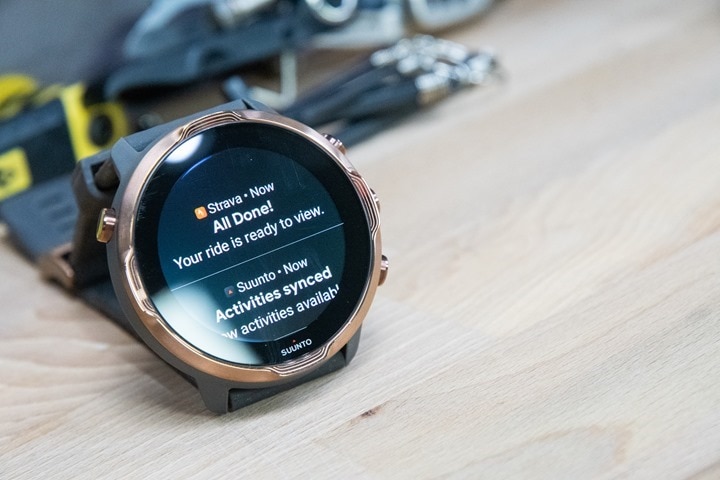
I was initially excited about the prospects of a Wear OS based Suunto watch. Sure, it’d come with all the baggage of Wear OS battery life and other Wear OS quirks, but it’d also fill a huge (and growing) gap in Suunto’s lineup on how to compete with other watch platforms that have music, maps, apps, and payments. Among many other things. While there will always be a market for a hardcore no-frills endurance watch, the size of that market is rapidly shrinking. The vast majority of people want more and more features that cross over into the rest of their lives/day, like music.
Thus, to my surprise it wasn’t actually Google’s Wear OS that let down this watch. It was Suunto’s own app…mostly. There’s no two ways about it, Suunto released this watch too early. It’s simply half-baked. The Suunto app does a fraction of what even Suunto’s own budget watches do. And that’s before we attempt to account for the $ 499 price tag. Which, we can’t. It’s overpriced by any market comparison you want to do – to any vendor you want to pick, and any model you want to choose.
But more than overpriced, it’s underfeatured. A fitness watch company whose own app platform doesn’t show your steps or workout trends anymore, nor allow any customization of workout data pages or metrics. An adventure-focused driven company that has centered itself around endurance that doesn’t allow you to follow a preplanned route during said adventure, or connect to any sensors. And that ignores burning battery at upwards of 30%/hour in some GPS profiles.
While some of this will be fixable in software (not the battery, that’s a chipset thing), I have low confidence that Suunto will make much progress in that anytime soon. They don’t have a road-map (I asked, and got no response), and historically speaking the last 2 years we’ve only seen Suunto remove features in their products and platforms. Firmware updates have gotten fewer and further between, with less and less features.
I wanted to believe Suunto had found some light at the end of the tunnel here, but mostly, I just got darkness. But…maybe that’s just the display turned off again.
Wanna Save 10%? Or found this review useful? Read on!


Hopefully you found this review useful. At the end of the day, I’m an athlete just like you looking for the most detail possible on a new purchase – so my review is written from the standpoint of how I used the device. The reviews generally take a lot of hours to put together, so it’s a fair bit of work (and labor of love). As you probably noticed by looking below, I also take time to answer all the questions posted in the comments – and there’s quite a bit of detail in there as well.
I’ve partnered with Clever Training to offer all DC Rainmaker readers an exclusive 10% discount across the board on all products (except clearance items). You can pick up the Suunto 7 from Clever Training. Then receive 10% off of everything in your cart by adding code DCR10BTF at checkout. By doing so, you not only support the site (and all the work I do here) – but you also get a sweet discount. And, since this item is more than $ 79, you get free US shipping as well.
Suunto 7 (select dropdown for color)
For European/Australian/New Zealand readers, you can also pick up the unit via Wiggle at the links below, which helps support the site too! With Wiggle, new customers get 10GBP (or equivalent in other currencies) off their first order for anything over 50GBP by using code NEWGB at check-out after clicking the links below.
Suunto 7 (EU/UK/AU/NZ – Wiggle)
Additionally, you can also use Amazon to purchase the unit (all colors shown after clicking through to the left) or accessories (though, no discount on Amazon). Or, anything else you pick up on Amazon helps support the site as well (socks, laundry detergent, cowbells). If you’re outside the US, I’ve got links to all of the major individual country Amazon stores on the sidebar towards the top. Though, Clever Training also ships there too and you get the 10% discount.
Thanks for reading!

